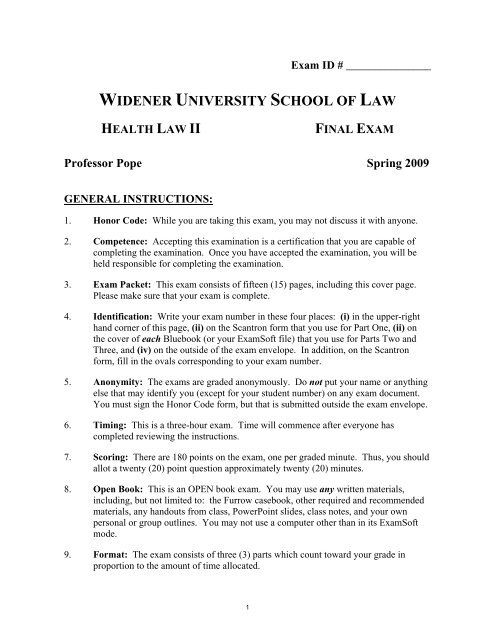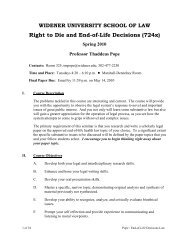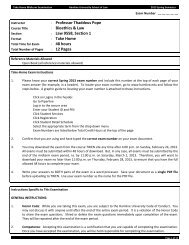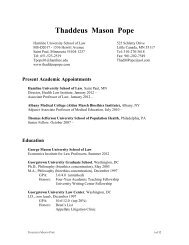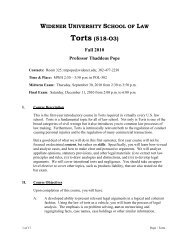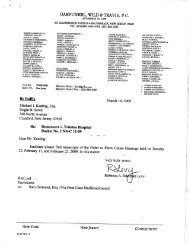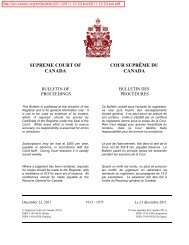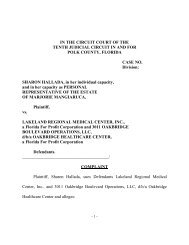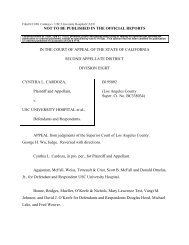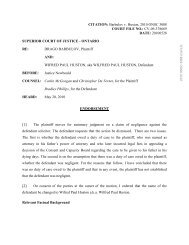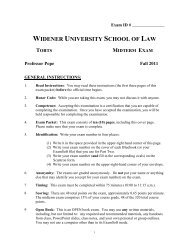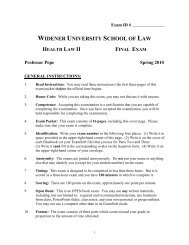Final Exam (Fall 2009) (with feedback) - Thaddeus Pope
Final Exam (Fall 2009) (with feedback) - Thaddeus Pope
Final Exam (Fall 2009) (with feedback) - Thaddeus Pope
Create successful ePaper yourself
Turn your PDF publications into a flip-book with our unique Google optimized e-Paper software.
handwriting, but must disregard (and not give you points for) writing that is too smallor sloppy to read or otherwise illegible.3. Outlining Your Answer: You are strongly encouraged to use one-fourth of theallotted time per essay question to outline your answers on scrap paper beforebeginning to write in your exam booklet or <strong>Exam</strong>Soft file.Do this because you will be graded not only on the substance of your answer but alsoon its clarity and conciseness. In other words, organization, precision, and brevitycount. If you run out of insightful things to say about the issues raised by the examquestion, stop writing until you think of something. Tedious repetition, regurgitationsof law unrelated to the facts, or rambling about irrelevant issues will negatively affectyour grade.4. Answer Format: Use headings and subheadings to separate chunks of textconcerning a particular party, a particular legal theory, or a particular element of alegal theory (e.g. “Patient v. Doctor - ADA” and “ADA – Harm to others defense”).Use short single-idea paragraphs (leaving a space between paragraphs).5. Answer Content: Answer all (but only) relevant issues that arise from the factpattern. Do not just summarize all the facts or all the legal principles relevant to anissue. Instead, apply the law you see relevant to the facts you see relevant. Take theissues that you identify and organize them into a coherent structure. Then, <strong>with</strong>in thatstructure, examine issues and argue for a conclusion.6. Citing Cases: You are welcome but not required to cite cases. It is sometimeshelpful to the reader, especially where a comparison or contrast to the exam factpattern might be fruitful. But do not cite case names as a substitute for stating the law.For example, do not write: “Plaintiff should be able to recover under Bragdon.”Why? What is the rule in that case? What are the facts in the instant case that satisfythat rule?7. Cross-Referencing: You may reference your own previous analysis (e.g. “the duty ofdefendant B is the same as defendant A, discussed above.”). But be very clear andprecise what you are referencing. Ambiguity is construed against the drafter.8. Balanced Argument: Facts rarely fit rules of law perfectly. So, recognize keyweaknesses in your position and make the argument on the other side. Do not makeonly slam-dunk arguments for a party. Make all plausible arguments implicated bythe facts. If some of those are weak, say why.9. Additional Facts: If you think that an exam question fairly raises an issue but cannotbe answered <strong>with</strong>out additional facts, state clearly those facts (implied by or at leastconsistent <strong>with</strong> the fact pattern) that you believe to be necessary to answer thequestion.3
DO NOT TURN THISPAGE UNTIL THEPROCTOR SIGNALS4
PART ONE15 questions worth three points each1. What does “community rating” and “experience rating” mean to insurancecompanies?A. Insurance companies set premiums by either community rating or experiencerating. In experience rating, the premiums are set based on the healthcareexperience of each group in using health care services. On the other hand, incommunity rating, for a given health insurance policy all subscribers in acommunity pay the same premium. Without community rating, older andsicker groups became less and less able to afford health insurance.B. Community rating and experience rating are the same thing and is a methodused by grievance committees at HMO's.C. Community rating and experience rating are the same thing and is a methodused by grievance committees at PPOs.D. All of the above.E. None of the above.2. What is “utilization review”?A. Utilization review is a systematic means for reviewing and controllingpatients’ use of health services and providers’ use of health care resources.B. Utilization review usually involves data collection, review and/orauthorization, especially for services such as specialist referrals and emergencyroom use, and particularly costly services such as hospitalization.C. Utilization Review ("UR") also known as Utilization Management is theprocess by which the health plan, payor or Utilization Review firm determinewhich services are medically appropriate and cost effective.D. Many insurance plans and all HMOs require that utilization review proceduresare followed prior to all inpatient and some outpatient and emergency care orthey will not pay for services rendered.E. All of the above.5
3. What is “Managed Care”?A. Managed care is defined as any system that integrates the financing anddelivery of appropriate medical care by means of at least one of the followingfour features: (1) contracts <strong>with</strong> selected physicians and hospitals that furnisha comprehensive set of health care services to enrolled members, usually for apredetermined monthly premium; (2) utilization and quality controls thatcontracting providers agree to accept; (3) financial incentives for patients touse providers and facilities associated <strong>with</strong> the Managed Care Organization’s(MCO) plan; and (4) assumption of some financial risk by doctors.B. Managed care is defined as any system that adds a middleman into theadministration of the healthcare delivery process.C. Managed care is defined as any system that is not the traditional health careinsurance indemnity type of system.D. Managed care is defined as any system that uses disease management andphysician profiling tools.E. None of the above.4. Which of the following are true?A. States may not force employers to purchase health insurance for theiremployees.B. States may not require self-insured employers to cover mental health.C. Both A and B.D. Neither A nor B.5. What does Utilization Review aim to do?A. Utilization Review aims to encourage providers to use more inpatient servicesas much as possible.B. Utilization Review aims to provide for effective pre-admission screening toavoid unnecessary admissions and provide early discharge planning to promoteprompt placement once patient has reached a lower level of care.C. Utilization Review aims to encourage the fee-for-service system.D. More than one of the above.6
6. The so-called “intermediate sanctions provision” of the Internal Revenue Code,26 U.S.C. § 4948, which applies to all 501(c)(3) hospitals among other entities:A. Shifts the sanctions associated <strong>with</strong> excess compensation and other benefitspaid to non-profit insiders from the non-profit hospital to any individual whoreceives a substantial excess benefit from the non-profit hospital.B. Permits the taxation of an organization manager who knowingly approves anexcess benefit transaction <strong>with</strong> a person prohibited from receiving such abenefit.C. Treats all officers, directors, and trustees of a non-profit as “disqualifiedpersons” subject to the excess benefit provision.D. A, B, and C are all correct.E. None of the above is correct.7. Dr. Friedman is an anesthesiologist whose application for staff privileges atWidener Hospital has been denied. The Credentials Committee of the medicalstaff reviewed her application, contacted all listed references, examined herresidency personnel files, and looked over her medical-school transcript, amongother peer-review activities. On the basis of its review of the paperwork, theCredentials Committee recommended to the Executive Committee of the medicalstaff that Dr. Friedman’s application be denied.When Dr. Friedman learned of the recommendation, she requested a hearing atwhich she or her counsel would be present, as well as an opportunity to introduceadditional evidence into the record. Her requests were granted. The ExecutiveCommittee then recommended denial to the hospital's board of directors, whichvoted unanimously to deny the application.Dr. Friedman is convinced that her application was turned down because thephysicians who are currently in the Department of Anesthesiology do not wantcompetition. Dr. Friedman has sued the medical staff, the hospital, and theboard for violations of the federal antitrust laws and has requested bothmonetary damages and injunctive relief (i.e. a judgment ordering the hospital toadmit her to the staff).Choose the most correct statement:7
A. The Health Care Quality Improvement Act probably provides a completedefense.B. The Health Care Quality Improvement Act probably provides a partial defense.C. The Health Care Quality Improvement Act probably provides a partial defenseif the hospital did a search of the National Practitioner Data Bank.D. None of the above. Private plaintiffs cannot sue under the Sherman Act.8. Which of the following are true concerning Medicaid?A. Medicaid is jointly financed by the federal and state governments.B. Each state’s participation in Medicaid is voluntary.C. Eligibility requirements vary widely from state to state.D. The share of the federal government’s contribution varies from state to state.E. All of the above.9. ERISA preempts the imposition of state insurance reform laws to self-insuredplans through:A. Implied PreemptionB. The Deemer ClauseC. The Savings ClauseD. Federal Court Jurisdiction8
10. Fyzur Drug Co. is a large, national, publicly-traded pharmaceutical firm.Among the products it manufactures and markets is a new fart-elimination drugthat Fyzur plans to sell under the name StinkAway. The marketing departmentat Fyzur has developed the following marketing strategy for StinkAway.Physicians will be able to earn rollover minutes and free ringtones every timethey fill out a questionnaire for a new patient placed on StinkAway. In addition,Fyzur will sponsor a "switchover" program under which cash payments will bemade to pharmacists each time a pharmacist persuades a physician to change aprescription order from a competitor's fart elimination drug to StinkAway.The vice-president for marketing has submitted the plan to you, as generalcounsel, for a legal review. Assuming that some of the patients involved will beMedicare beneficiaries, which of the following statements is the most correct?A. If both of the marketing strategies conform to industry standards for newproductmarketing, they should be lawful under fraud & abuse laws.B. The product-switchover program probably violates fraud & abuse laws, but notthe rollover minutes and free ringtones program.C. The rollover minutes and free ringtones program probably violates fraud &abuse laws, but not the product-switchover program.D. Both marketing programs probably violate fraud & abuse laws.11. A 501(c)(3) hospital operates an in-house industrial laundry. The CEO wants tomarket the excess capacity in the laundry (estimated to be about 4 percent oftotal capacity) by performing services for local nursing homes and hotels.A. Such business activity would be unrelated to the hospital’s charitable purposeand would proably jeopardize the hospital’s tax-exempt status.B. Such business activity exposes the hospital to possible sanctions because itmight constitute an Excess Benefit Transaction.C. Such business activity would probably not jeopardize the hospital’s tax-exemptstatus, but the hospital would have to pay income tax on the revenue earnedfrom this business activity.D. Both A and B.E. Both B and C.9
12. Matthias works for Employer A and has been covered continuously under A’sgroup health plan. Matthias’s wife, Lisa, works for Employer B. B maintains agroup health plan that imposes a 12-month preexisting condition exclusion on allnew enrollees. Matthias enrolls in B’s plan, but also stays covered under A’splan. Matthias presents B’s plan <strong>with</strong> evidence of creditable coverage under A’splan.A. B’s plan must reduce the preexisting condition exclusion period that applies toMatthias by the number of days of coverage that Matthias had under A’s plan,as of Matthias’s enrollment date in B’s plan.B. Under COBRA, B’s plan may not impose an exclusion for preexistingconditions.C. Under HIPAA, B’s plan may not impose an exclusion for preexistingconditions.D. None of the above.13. You work for a large nonprofit tax-exempt hospital system and are in charge ofthe monthly newsletter. Since the newsletter reaches a large targeted audience(40,000 people), various companies have expressed interest in advertising in yourpublication.A. The revenue from the newsletter will probably not be significant enough tojeopardize the hospital’s tax-exempt status.B. There is no de minimus exception. The revenue from the newsletter probablyis sufficient to jeopardize the hospital’s tax-exempt status.C. The hospital will have to pay federal income tax on the advertising revenue.D. A and C.E. B and C.10
14. In a majority of states you must apply for a Certificate of Need in order to:A. Establish a new facility or serviceB. Change the patient capacity of an existing facility or serviceC. Acquire or replace major medical equipmentD. All of the above15. Three major managed care and health insurance companies in Delaware agreednot to contract <strong>with</strong> any Delaware pharmacy at above a certain reimbursementrate. If you represent a Delaware pharmacy:A. You have a reasonable lawsuit against the managed care and health insurancecompanies under the Clayton Act.B. You have a reasonable lawsuit against the managed care and health insurancecompanies under the Sherman Act.C. You can probably establish a per se violation, and avoid the need todemonstrate market power or harm to competitionD. Both A and C.E. Both B and C.11
PART TWO3 short essay question worth a total combined 70 pointsShort Essay 1 - 10 points/minutesLisa and her husband both work as housecleaners in a motel on Route 202, for minimumwage and no health benefits. Lisa is pregnant but they are not sufficiently poor to qualify forMedicaid. Lisa is terrified of giving birth in the city's public hospital, and wants to have herbaby at the Super Fabulous Birthing Center in nearby Wealthy Suburb Hospital. That hospitalwill not accept her, however, <strong>with</strong>out evidence of health insurance.What law can Lisa use to force Wealthy Suburb Hospital to admit her for the delivery ofher baby? What must she do in order to take advantage of that law?Short Essay 2 - 30 points/minutesYou represent Widener Hospital. Linda Bosse is the CEO and has sought your advice andcounsel on several questions that have arisen at various stages in the development andcreation of Widener Hospital. Widener Hospital is a recently constructed 175-bed full servicehospital. Both the construction of Widener Hospital and the purchase of the equipment used<strong>with</strong>in Widener Hospital were financed <strong>with</strong> tax exempt debt. Widener Hospital is aparticipating provider in Medicare.Widener Hospital wants to enter into a seven year contract for management services <strong>with</strong> afor-profit company (“Manager”). The Manager will manage several units in the hospital,including the Intensive Care Unit and the Neonatal Intensive Care Unit. The Manager wantsto be reimbursed for all of its expenses and, in addition, be paid a management fee equal totwenty percent (20%) of the hospital’s revenues. The Manager also would like to be paid abonus of $100,000 if Widener Hospital meets certain performance targets. The Manager isowned by several physicians who are members of the Widener Hospital medical staff andwho routinely refer patients to Widener Hospital for inpatient and outpatient services.Discuss the extent to which the proposed contract <strong>with</strong> the Manager will create risk toWidener hospital’s tax exempt bonds, and what, if any, changes you would recommendbe made to the contract to reduce or eliminate those risks.12
Short Essay 3 - 30 points/minutesWest Chester Regional Hospital is a non-profit institution under state and federal law. TheCEO, Max Mahlman, has handpicked Board members who never question his non-traditionaldecisions, including: outlandish parties, personal use of the helicopter, and huge salaries formanagement. Max has installed his wife, a convicted felon, in the hospital’s billingdepartment, where she earns a large commission on increases in West Chester’s revenues.Max also secretly controls the only other health care facility in town. Max must be stopped.Evaluate three (3) important causes of action that can be asserted against Max and/orthe Hospital. Identify who the plaintiff could be for each.13
PART THREE1 long essay worth 65 pointsYou are an associate at a local law firm. Victoria, another associate, has started to draft acomplaint, but she suddenly went into labor and is now on maternity leave. You must takeover. Victoria has already reviewed the relevant documents and interviewed the clients.Based on that investigation, Victoria has drafted the factual allegations portion of thecomplaint. But she did not indicate what legal claims these factual allegations can support.The senior partner has asked you to evaluate the legal theories that the client can pursue (andmight include in the complaint). The partner has asked you to organize your memo by legaltheory.The PartiesUnited States District Courtfor the District of Delaware1. Plaintiff was employed for over sixteen years between 1992 and 2008, by defendantConcord Pike Clinic.2. Defendant, the Concord Pike Clinic ("Clinic"), is a professional corporation qualified asan exempt organization pursuant to § 50l(c)(3) of the Internal Revenue Code. Clinic, atany given time, employs approximately 240 general and specialty physicians who provideservices to Medicare and Medicaid beneficiaries. The majority of the Clinic employeesare the owners and shareholders of the Clinic.3. Defendant, Naamans Road ("Hospital"), is a non-profit corporation, approximately 250-bed acute health care facility, located at Wilmington, Delaware and qualified as anexempt organization pursuant to § 501(c)(3) of the Internal Revenue Code. All of thephysicians <strong>with</strong> active staff privileges at Hospital are employed by the Clinic androutinely refer all of their patients to Defendant Hospital for inpatient and other servicespaid for by Medicare and Medicaid.4. Defendant Clinic is not related to the Hospital, through common membership, governingbodies, trustees, officers, and the like.Conduct of the Defendants5. In fiscal year 2006-2007, Hospital provided Defendant Clinic <strong>with</strong> notes and other loansin principle amounts totaling more than $2.5 million, at no or below market interest rates,which notes and loans were in amounts and on such terms as Clinic could not obtain incommercial or private markets.14
6. In fiscal year 2007-2008, Defendant Hospital provided Defendant Clinic <strong>with</strong> a line ofcredit totaling $10,000,000 at no or below market interest, which line of credit theDefendant Clinic could not obtain in such amounts and on such terms in the commercialor private markets.7. In the fiscal year ending June 30, 2007, Defendant’s Defendant Hospital transferred$7,290,671 directly to Defendant Clinic, which transfer did not represent and did notpurport to represent the payment of fair market value for bona fide services rendered.8. Defendant Hospital entered clinical director and department chair compensation contracts<strong>with</strong> physicians employed by defendant Clinic, priced at payment levels characterized inwriting as "excessive" by both defendants.9. At the time of the aforesaid loans and cash transfers, the Defendant had knowledge ofpublic announcements and “appropriate practices” publications by authorizedrepresentatives of applicable agencies related to Medicare and Medicaid reimbursement,including the Office of Inspector General of the Department of Health and HumanServices.10. Coincident <strong>with</strong> the above-described conduct, Defendant Clinic engaged in a pattern andpractice of referring large volumes of patients to the Defendant Hospital, who, in turn,billed Medicare, Medicaid and other government health care programs and received inexcess of $800 Million dollars for the referred services.11. Virtually all Clinical Laboratory and radiology services provided to federally insuredpatients by any provider affiliated <strong>with</strong> Defendant Hospital, are provided as a result ofreferrals from physicians <strong>with</strong>in the employ of the Defendant Clinic.12. Among the scores of physicians, medical clinics and medical and dental professionalcorporations <strong>with</strong>in the region served by defendant Hospital, the only physicians orphysician group that defendant Hospital, provided loans and other transfers is DefendantClinic (and its physicians).13. Defendant Clinic used the substantial transfers of cash and loans described herein to fund,inter alia, individual physician compensation, bonuses, benefits, malpractice insurance,pension and benefit plans, and a physician profit sharing plan.14. Defendant Clinic currently receives payments under Medicare for outpatientgastroenterology services. These services are provided almost exclusively by DefendantClinic in its Ambulatory Surgery Center ("ASC") facility, pursuant to an agreementbetween the Defendants. The terms of this agreement require that Defendant Hospitalforgoes virtually of all of the outpatient endoscopy services it would normally provide(and had been providing from 1992 thru 2001) but for the terms of the agreementallowing Defendant Clinic to provide these services instead.-- END --I enjoyed the class, and hope that you have an enjoyable summer!15
EXAM ID ___________Multiple Choice1. A 4. C 7. C 10. D 13. D2. E 5. B 8. E 11. C 14. D3. A 6. D 9. B 12. A 15. E Total ____ of 45 (3pt each)Essay 1EMTALA --The hospital participates in Medicare and has an ED. 1If Lisa presents on hospital property, then she must be screened (in the standard way that such 2patients are screened)If she presents when in active labor, then when she is screened the hospital will find an EMC. 3The hospital must stabilize the EMC, which in the case of labor means delivery. 3It is unlikely that any of the transfer exceptions apply. 1ADA – This is not an option because Lisa has no disability 0Medicaid – This is not an option because the fact pattern states that she does not qualify. 0TOTAL 10Essay 2501(c)(3) --Private inurement --The management company is likely an insider, given its control position. 10The management company was to be paid (both its fee and bonus) based on revenue. This 10looks like a dividend, like profits.Private benefit – Even if the management company weres not an insider, the payments would 5constitute private benefit because they are likely not FMV.Antikickback -- Since the management company is owned by staff docs, the payments could be a 5remuneration for referrals. Violation of AKS could jeopardize exempt status. (A similar analysiscould be made under Stark because the owner docs may refer for DHS.)EBT – This is not relevant because it does not jeopardize the exempt status of the hospital. 0TOTAL 30Essay 3501(c)(3) --Max is an insider and uses hospital resources like the helicopter for non-exempt purposes.10The huge salaries to management (insiders) are private inurement (or at least benefit).The wife earns a commission based on revenue. This is private inurement (or at least benefit).EBT --Same grounds as private inurement because the managers are DQPs and payments are not FMV. 10But the penalties run against Max and the EBT recipients.AKS --If the management includes doctors who make referrals, at least one purpose of the salaries may be 10to induce referrals.Stark --If the management includes doctors who make referrals, those referrals are for DHS from an entity 10in which the doctors have a financial interest.False Claims Act --If a claim has been made out under AKS or Stark, the the hospital’s billing for such services will 10constitute implied false certification.The wife, given her incentives and her history, may be upcoding in order to increase commissions. 10But as in Krizek, the intent is not hers but Max’s or the hospital’s, since they are the defendants.Sherman Act --“Secret” control of the only competitor implies a horizontal agreement for an illicit purpose. Any 10agreement may likely be analyzed under the per se rule, or at least quick look. (Some assumed thatMax “owned” the other facilty, triggering Clayton. This is unstated but consistent <strong>with</strong> the facts.)TOTAL [Top 3 only] 30
Long Essay501(c)(3) --The chairperson contracts probably constitute private inurement. 7The loans and payment to the clinic probably constiutes private inurement (or at least benefit). 7The clinic (distinct from the hospital) cannot have shareholders.EBT --Same grounds as private inurement because the managers are DQPs and the payments are not 6FMV.AKS --Remuneration = the loan, line of credit, and other monies 5-715The defendants had knowledge that this was wrong 9Given the high volume of referrals ( 10), can infer the remuneration was to induce.Stark --The clinic doctors refer to the hospital in which they have a financial interest for DHS. The10hospital billed for DHS.False Claims Act --Given the incentives here, it is possible that billed services were not “medically necessary.”10If a claim has been made out under AKS or Stark, the the hospital’s billing for such services willconstitute implied false certification.Sherman Act --The ASC and the hospital (horizontal competitors) have agreed to divide the market. This is a per 10se violation. (The agreement among clinic doctors is not a problem because they are all part of oneeconomic entity.)TOTAL 65<strong>Final</strong> <strong>Exam</strong> Total _____ of 180


